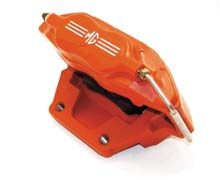
 |
MGF/TF Brake Options |
Brake Fade
Is brake fade a problem on a standard road-going MGF? No, not really. It is only when you take your MG to a track and give it some real 'welly' do the standard brake's inherent weaknesses become exposed. So for those track day warriors, read on!
Brake fade can occur in two ways, both of which are caused by excessive heat:
Pedal
fade
occurs as the result of the brake hydraulic fluid boiling in the calipers. It is
characterised by the pedal feel getting spongy and travelling closer to the floor. The
sensation is somewhat similar to the feel that the brakes have when they need bleeding.
How
do you prevent brake fade?
Pedal
fade
can often be eradicated simply by flushing out the old fluid and replacing it with fresh,
high temperature resistant, fluid (e.g., replacing OE DOT4 fluid for higher performance
DOT5). An important point to note however, is that once the fluid has boiled, it no longer
has the ability to resist boiling or aeration, and therefore must be completely flushed
from the system and replaced with new.
Unfortunately,
all non-silicone based brake fluids are hydroscopic - they absorb atmospheric moisture
over time. The more water brake fluid contains, the less resistant it is to boiling under
extremis.
If
pedal fade reoccurs even with new fluid, then a better grade fluid must be used or steps
must be taken to isolate the brake pad heat from the fluid in the calipers.
Pad
fade can
be overcome as simply as backing off the brakes long enough to allow them to cool.
However, the cause of the pad fade must be carefully considered if it is found to be a
recurrent problem.
1. The
operating temperature range of the pad.
Correcting this problem may only require installing the next higher heat range pad
compound. For example, exchanging the standard, original-equipment, road going pads for a
fast road pad, such as Mintex's 1144.
2. Specification
of the brake disc, or rotor.
If the vehicle is already equipped with a high temperature pad, the next area that
requires attention must be brake rotor size and cooling. It
is the brake rotor's job to absorb then dissipate the heat generated by applying the
brakes (friction dissipates the energy absorbed from motion as heat) - and to keep that
heat 'locked' out of the brake pads to prevent them from overheating. Design
considerations of the brake rotor include the cooling vents - or vane configuration -
rotor mass, surface area and wall thickness. All these factors must be optimised to
effectively manage the heat generated. In some cases, to overcome pad fade, a larger or
heavier rotor may be necessary. It may also be necessary to install or increase the
cooling duct system to provide additional airflow to the rotor. In any case, the system
must be configured to effectively manage the brake heat or the consequential fade problems
will continue to occur.